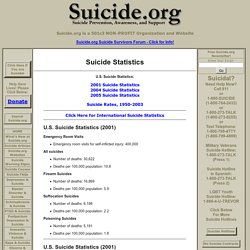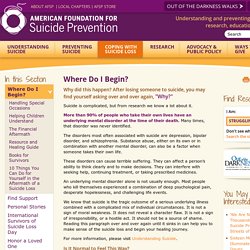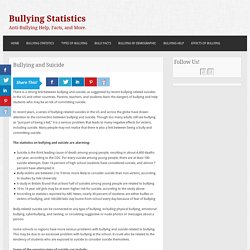

Suicide Statistics at Suicide.org! Suicide Statistics, Suicide Statistics, Suicide Statistics, Suicide Statistics, Suicide Statistics! U.S.

Suicide Statistics: U.S. Suicide Statistics (2001) Emergency Room Visits Emergency room visits for self-inflicted injury: 400,000 All suicides Number of deaths: 30,622 Deaths per 100,000 population: 10.8 Firearm Suicides Number of deaths: 16,869 Deaths per 100,000 population: 5.9 Suffocation Suicides Number of deaths: 6,198 Deaths per 100,000 population: 2.2 Poisoning Suicides Number of deaths: 5,191 Deaths per 100,000 population: 1.8 Breakdown by Gender / Ethnicity / Young, Old Age Groups Further Breakdown by Gender / Ethnicity.
UCLA Logon. Revealed: Shocking Bullying Statistics 2014! The Essential Guide to Bullying Statistics 2014 and recent bullying percentages.

Also browse: General Statistics on Bullying | Bullying Suicide Statistics | LGBT Bullying Statistics There is no doubt that bullying is a problem in U.S. schools, but just how much of a problem is it? Where Do I Begin? Why did this happen?

After losing someone to suicide, you may find yourself asking over and over again, "Why? " Suicide is complicated, but from research we know a lot about it. More than 90% of people who take their own lives have an underlying mental disorder at the time of their death. Many times, that disorder was never identified. The disorders most often associated with suicide are depression, bipolar disorder, and schizophrenia.
These disorders can cause terrible suffering. An underlying mental disorder alone is not usually enough. So What Exactly Is Bullying? How suicide affects others - Survivors of Bereavement by Suicide. There is no blueprint for how we react to and cope after a suicide.

We each have our own relationship with the person who died and we all grieve in our own way and at our own pace. When someone grieves in a different way to you, it doesn’t mean that they don’t care – they are just finding their own way to cope. But it can be hard if they behave in a way that you can’t relate to. It can also be difficult to express our own grief around others if they are reacting differently, especially if those people also had a close relationship with the person who died. Patience and understanding is helpful and it important that you try and find somewhere you can share your feelings. Read on to find out more about suicide bereavement can affect: Partners Losing the person you have chosen to share your life with can destroy your hopes and expectations for the future. “I felt I was not good enough to stay alive with….” “This wouldn’t have happened if (s)he hadn’t been with you…” Siblings.
Pros and Cons of Cyber Bullying. In today’s world young people have access to the entire world through the use of computers, cell phones, and other electronic devices.

The benefits of this have been great, but with the good there has to be the bad. Cyber Bullying is defined as any form of repeated harassment to a person using electronic devices and the internet. It is a growing issue that youth are facing today. Studies have shown that one third of students have faced some form of cyber bullying in their life, that is a startling high amount.
While it is hard to imagine any good coming from something so hurtful, could there be pros to go with the cons? The Pros of Cyberbullying. Bullying and Suicide. There is a strong link between bullying and suicide, as suggested by recent bullying-related suicides in the US and other countries.

Parents, teachers, and students learn the dangers of bullying and help students who may be at risk of committing suicide. In recent years, a series of bullying-related suicides in the US and across the globe have drawn attention to the connection between bullying and suicide. Though too many adults still see bullying as “just part of being a kid,” it is a serious problem that leads to many negative effects for victims, including suicide.
There's No Such Thing As a Bully: Parental Perspective. Since I first began writing this column, the goal has been to share my previous experience with parenting a bullied child, in hopes of providing some support.

It’s been an enlightening journey. Years ago, during his first year in a new school, my son suddenly faced constant name-calling, physical attacks and intimidation from a small group of students with a reputation for bullying. He was a target. I watched and worried as the self-esteem of my usually confident and happy child crumbled, until he told me he just couldn’t take it anymore. It was excruciating. Like any parent, I wanted to make it stop and naively expected to go to the school and have them “solve” the problem. It’s because of that experience that I learned the importance of handling each situation appropriately.
I’ve heard of administrators turning a blind eye and ignoring the problem, or waiting until the victim finally fights back and suspending him or her. Whipping Boy - The New Yorker. In 1971, I met a boy who changed my life forever.

I was ten and he was twelve when, for a few indelible months, we roomed together in a British-style boarding school perched on an alpine meadow high above Geneva. None of the schools I had previously attended—two public, one parent-run, and one private—prepared me for the eccentricities of Aiglon College. Early mornings were given over to fresh-air calisthenics, cold showers, and meditation. Afternoons were reserved for skiing and hiking. A retired opera singer with ill-fitting dentures taught elocution. A wildly favorable exchange rate made it possible for my mother, recently widowed, to send me to a school far beyond her means.
To neutralize the income inequality of its charges, the school prohibited parents from sending their sons and daughters spending money. How does a middle-class Jewish kid from New York end up at a fancy Christian-inflected boarding school in Switzerland? “You know what that tree is used for?” “Whoa!”